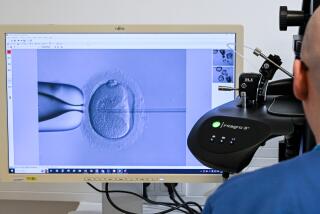Newlywed Dies in Crash, but Hopes for Children Live in Extracted Sperm : Florida: A rare surgical procedure performed after groom’s death could allow widow to become pregnant. But chances of success are slim, doctors warn.
ORLANDO, Fla. — The remarkable legacy of 22-year-old Emanuele Maresca was born of tragedy.
Maresca was killed in a car accident just 16 days after his wedding. But a rare surgical procedure performed after his death may allow Maresca’s young widow to give birth to his child.
A specialist conducted post-mortem surgery and removed an organ that stores sperm, allowing Maresca’s reproductive fluid to be extracted, frozen and stored for later use by his 22-year-old wife, Pamela.
A Los Angeles doctor said he has performed a similar procedure on dead men four times, but the frozen sperm has never led to a pregnancy. He and the Florida physician say that if Pamela Maresca becomes pregnant, it apparently would be the first conception with sperm taken from a dead man.
“I think it’s just wonderful. It gives us all something to hang onto,” said Maresca’s widow. “Even though we’ve lost Manny, we will have something of him in the future. I’m sure he would agree with what we’ve done.”
Tragedy struck the newlyweds the night of May 19 after they left their jobs at a Titusville restaurant. They bought some milk and cookies, got into their new car and began the late-night drive to their Orlando-area home.
Just a few miles from their destination in Oviedo, Maresca may have been distracted as he rounded a curve, his widow said. He lost control of the car and crashed into a utility pole, suffering massive head injuries.
The college student was rushed to Orlando Regional Medical Center, where his uninjured wife, his mother and father and their large family waited throughout much of the next day to find out whether doctors could save him.
They failed. Doctors advised the family late in the day that Maresca’s brain had stopped functioning. The grieving wife and Maresca’s parents began making arrangements to harvest and donate Maresca’s vital organs once he died.
“I was distraught, and I said to Pamela that I would have been so glad if she had been pregnant,” recalled Leslie Maresca, the victim’s mother.
The mother’s comment led to efforts to extract semen from Maresca through the use of a special machine often used for paraplegics and others unable to engage in sexual activity.
Those efforts didn’t work. So Dr. Mark Jutras, a reproductive endocrinologist, was called in. Jutras conducted surgery after Maresca’s death and extracted the victim’s epididymis, a tubular duct system where sperm is stored.
Jutras then dissected the epididymis and sent it to an Altamonte Springs lab that freezes and stores sperm and assists physicians with therapeutic inseminations. A lab technician managed to recover two samples of sperm.
The sperm was frozen and will be held in storage for about a year, when Pamela Maresca plans to be artificially inseminated after one of her eggs is fertilized with the sperm in a laboratory.
“We were very eager to have children in the future, but we had never discussed the possibility of anything like this,” Pamela Maresca said.
Leslie Maresca was overjoyed by what she considers an “almost miraculous series of circumstances”--that Dr. Jutras had experimented with the epididymis and was available immediately, that her daughter-in-law was so enthusiastic about the idea and that the cryogenic lab had only recently gone into operation.
“There were so many wonderful coincidences that we have to believe God had a hand in this,” Leslie Maresca said. “Maybe it was just meant to happen.”
She and her husband, Armando, have five other children. Emanuele was their oldest.
Jutras said he had experimented with rats during his medical training, removing the epididymis and cutting it up to get the sperm, but had never performed the procedure on a human.
“I saw no reason not to do it in this case. I was pretty confident it could be done although I had never performed the procedure on a human patient before, and I didn’t know if it had ever been done,” Jutras said.
After the operation, Jutras discovered there had been one other reported case, in 1980.
Dr. Cappy Miles Rothman, a urologist in Los Angeles, extracted the epididymis and obtained sperm from a 30-year-old man fatally injured in a car wreck. It was done at the request of the victim’s father.
At the time of Rothman’s November, 1980, report in The American Fertility Society’s journal, Fertility and Sterility, there were no provisions for lab fertilization so that such sperm could be used for pregnancy.
Laboratory fertilization techniques were developed shortly after that, Rothman said.
Rothman said he has performed the same surgical procedure three more times because “it invariably makes the family very happy to have it.”
“I assume they wanted the option to use it in the future, but I don’t know of a case that it has resulted in a pregnancy,” Rothman said.
Maresca, a student at the University of Central Florida, wanted to become a professor, teaching creative writing and English.
“He left us songs, poems and stories, which I am going to get published,” his mother said. “He left us with a lot of wonderful things. It was quite a legacy for someone so young.”
More to Read
Sign up for Essential California
The most important California stories and recommendations in your inbox every morning.
You may occasionally receive promotional content from the Los Angeles Times.









